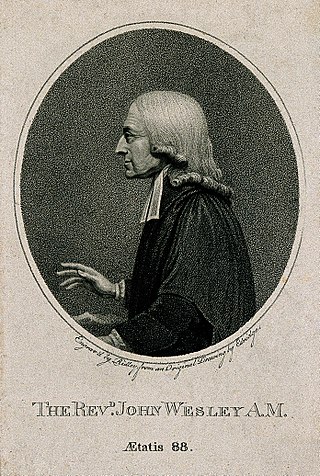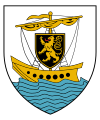
The Reverend is an honorific style given before the names of certain Christian clergy and ministers. There are sometimes differences in the way the style is used in different countries and church traditions. The Reverend is correctly called a style, but is sometimes referred to as a title, form of address, or title of respect. The style is also sometimes used by leaders in other religions such as Judaism and Buddhism.

The Church of Ireland is a Christian church in Ireland, and an autonomous province of the Anglican Communion. It is organised on an all-Ireland basis and is the second-largest Christian church on the island after the Roman Catholic Church. Like other Anglican churches, it has retained elements of pre-Reformation practice, notably its episcopal polity, while rejecting the primacy of the pope.
In Christianity, a collegiate church is a church where the daily office of worship is maintained by a college of canons, a non-monastic or "secular" community of clergy, organised as a self-governing corporate body, headed by a dignitary bearing a title which may vary, such as dean or provost. In its governance and religious observance a collegiate church is similar in some respects to a cathedral, although a collegiate church is not the seat of a bishop and has no diocesan responsibilities. Collegiate churches have often been supported by endowments, including lands, or by tithe income from appropriated benefices. The church building commonly provides both distinct spaces for congregational worship and for the choir offices of the canons.

A dean, in an ecclesiastical context, is a cleric holding certain positions of authority within a religious hierarchy. The title is used mainly in the Roman Catholic Church, the Anglican Communion, and many Lutheran denominations. A dean's assistant is called a sub-dean.
The Very Reverend is an honorific style given to higher-ranking members of a clergy. The definite article "the" should always precede "Reverend" when used before a name, because "Reverend" is an honorific adjective, not a title.

The Anglican ministry is both the leadership and agency of Christian service in the Anglican Communion. "Ministry" commonly refers to the office of ordained clergy: the threefold order of bishops, priests and deacons. More accurately, Anglican ministry includes many laypeople who devote themselves to the ministry of the church, either individually or in lower/assisting offices such as lector, acolyte, sub-deacon, Eucharistic minister, cantor, musicians, parish secretary or assistant, warden, vestry member, etc. Ultimately, all baptized members of the church are considered to partake in the ministry of the Body of Christ.

The Diocese of Clonfert is a Roman Catholic diocese in the western part of Ireland. It is in the Metropolitan Province of Tuam.

The Roman Catholic Diocese of Galway, Kilmacduagh and Kilfenora is a Roman Catholic diocese in the west of Ireland. It is in the ecclesiastical province of Tuam and is subject to the Metropolitan Archdiocese of Tuam. The deanery of Kilfenora, previously a diocese in its own right, lies in the ecclesiastical province of Cashel. The ordinary is Bishop Michael Duignan who was appointed on 11 February 2022.

The Archdiocese of Tuam is an ecclesiastical territory or archdiocese of the Catholic Church located in western Ireland. The archdiocese is led by the Archbishop of Tuam, who serves as pastor of the mother church, the Cathedral of the Assumption and Metropolitan of the Metropolitan Province of Tuam. According to tradition, the "Diocese of Tuam" was established in the 6th century by St. Jarlath. The ecclesiastical province, roughly co-extensive with the secular province of Connacht, was created in 1152 by the Synod of Kells.

The Collegiate Church of Saint Mary the Virgin, also known as St Mary's Collegiate Church, is a large Anglican church in Youghal, east County Cork, Ireland. Dating to roughly 1220 and dedicated to the Virgin Mary, it is part of Youghal Union of Parishes, in the United Dioceses of Cork, Cloyne and Ross.
Edmund Ffrench, O.P. (1775–1852) was the Roman Catholic Warden of Galway and Bishop of Kilmacduagh and Kilfenora.
John Bodkin was a Roman Catholic Warden of Galway. After his death, his body was said to have been the subject of a miracle, because it was believed to have not decayed.
Anthony Blake was an Irish prelate of the Roman Catholic Church. He served as Bishop of Ardagh and Clonmacnoise from 1756 to 1758 and Archbishop of Armagh from 1758 to 1787.
The Dean of Tuam is a post held in the Diocese of Tuam, as head of the cathedral chapter from after the creation of the diocese at the Synod of Rathbreasail in 1111.
George Joseph Plunket Browne (1795–1858) was an Irish Roman Catholic clergyman. Born to a "well-known Roscommon family", he served as Bishop of Galway from 1831 until 1844, and afterward as Bishop of Elphin, until his death on 1 December 1858. He was charged with being a "Cullenite" in 1855, that is, a follower of ultramontane Paul Cardinal Cullen.
A rector is, in an ecclesiastical sense, a cleric who functions as an administrative leader in some Christian denominations. In contrast, a vicar is also a cleric but functions as an assistant and representative of an administrative leader.
Events from the year 1484 in Ireland.
The Venerable Gary Lea Hastings has been Archdeacon of Tuam since 2006.
Kilconickny is a civil parish in the county of Galway, Connaught, Ireland.

The Diocese of Tuam, Limerick and Killaloe is a diocese of the Church of Ireland that is located in the west of Ireland. The diocese was formed by a merger of the former Diocese of Tuam, Killala and Achonry and the former Diocese of Limerick and Killaloe in 2022, after the retirement of the separate dioceses' bishops and the appointment of Michael Burrows as bishop of the united diocese. It is in the ecclesiastical province of Dublin. It is one of the eleven Church of Ireland dioceses that cover the whole of Ireland. The largest diocese by area in the Church of Ireland, it covers all of counties Clare, Galway, Kerry, Limerick and Mayo, plus parts of counties Cork, Sligo, Roscommon, Offaly, Laois and Tipperary.












